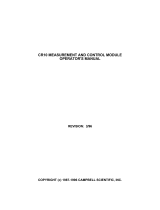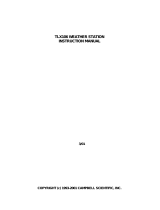Campbell Scientific LI200S-L LI-COR Silicon Pyranometer Owner's manual
- Category
- Measuring, testing & control
- Type
- Owner's manual
This manual is also suitable for
Campbell Scientific LI200S-L LI-COR Silicon Pyranometer
The Campbell Scientific LI200S-L LI-COR Silicon Pyranometer is a high-precision sensor designed to measure solar radiation. It features a silicon photovoltaic detector with a blue-enhanced coating for improved sensitivity in the visible spectrum. The LI200S-L is cosine-corrected, meaning it can accurately measure radiation from any angle of incidence up to 80 degrees.
This sensor is ideal for a wide range of applications, including:
- Monitoring solar radiation for photovoltaic system performance evaluation
- Measuring plant canopy photosynthesis and transpiration
Campbell Scientific LI200S-L LI-COR Silicon Pyranometer
The Campbell Scientific LI200S-L LI-COR Silicon Pyranometer is a high-precision sensor designed to measure solar radiation. It features a silicon photovoltaic detector with a blue-enhanced coating for improved sensitivity in the visible spectrum. The LI200S-L is cosine-corrected, meaning it can accurately measure radiation from any angle of incidence up to 80 degrees.
This sensor is ideal for a wide range of applications, including:
- Monitoring solar radiation for photovoltaic system performance evaluation
- Measuring plant canopy photosynthesis and transpiration








-
 1
1
-
 2
2
-
 3
3
-
 4
4
-
 5
5
-
 6
6
-
 7
7
-
 8
8
Campbell Scientific LI200S-L LI-COR Silicon Pyranometer Owner's manual
- Category
- Measuring, testing & control
- Type
- Owner's manual
- This manual is also suitable for
Campbell Scientific LI200S-L LI-COR Silicon Pyranometer
The Campbell Scientific LI200S-L LI-COR Silicon Pyranometer is a high-precision sensor designed to measure solar radiation. It features a silicon photovoltaic detector with a blue-enhanced coating for improved sensitivity in the visible spectrum. The LI200S-L is cosine-corrected, meaning it can accurately measure radiation from any angle of incidence up to 80 degrees.
This sensor is ideal for a wide range of applications, including:
- Monitoring solar radiation for photovoltaic system performance evaluation
- Measuring plant canopy photosynthesis and transpiration
Ask a question and I''ll find the answer in the document
Finding information in a document is now easier with AI
Related papers
-
Campbell Scientific LI200X-L Owner's manual
-
Campbell Scientific LI200X-LC Owner's manual
-
Campbell Scientific SP-LITE Owner's manual
-
Campbell Scientific CM3 and Zonen Owner's manual
-
Campbell Scientific MetData1 Weather Station Owner's manual
-
Campbell Scientific MetData 1 Owner's manual
-
Campbell Scientific UT10 Owner's manual
-
Campbell Scientific MetData1 Owner's manual
-
Campbell Scientific SP230 and SP230SS Heated Pyranometers Owner's manual
-
Campbell Scientific CM6/CM10 Tripod Weather Station Owner's manual
Other documents
-
Campbell LP02 User manual
-
 Campbell Manufacturing SDM-SW8A User manual
Campbell Manufacturing SDM-SW8A User manual
-
 Campbell Manufacturing CR10 User manual
Campbell Manufacturing CR10 User manual
-
Campbell Hausfeld Network Card SDM-CD16AC User manual
-
 Campbell Manufacturing TLX106 User manual
Campbell Manufacturing TLX106 User manual
-
EKO ML-01 Si-Pyranometer Owner's manual
-
Topcon UVR-T2 User manual
-
Delta OHM PYRAsense03 User manual
-
Delta OHM LPPYRA-Lite Pyranometer User manual
-
EKO ML-02 Si-Pyranometer Owner's manual










